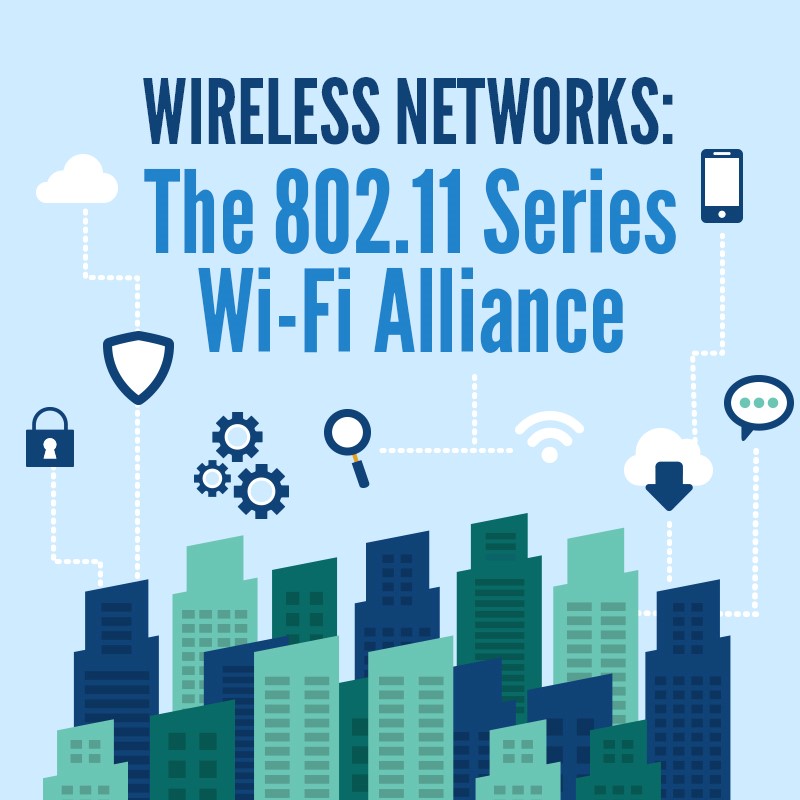
Wireless Networks – The 802.11 Series – Wi-Fi Alliance
By Tom Carpenter On 06/29/2016 - 107 Comments
Our next post is about the Wi-Fi Alliance and other regulatory agencies that play an important role in implementing and monitoring wireless networks.
The Wi-Fi Alliance is a non-profit organization that promotes the use and implementation of Wi-Fi technology and also certifies Wi-Fi products that conform to subsets of the 802.11 standard. Founded in 1999, Wi-Fi Alliance has since developed interoperability certification programs, which ensure that Wi-Fi devices across various brands work seamlessly. The Wi-Fi Alliance owns the "Wi-Fi" trademark and it tests various aspects of 802.11 specifications on products provided by the vendors, for interoperability. If the products pass these tests, Wi-Fi Alliance certifies it as Wi-Fi Certified TM for the specific 802.11 technology. Wi-Fi Certified TM is an internationally recognized certificate of approval for products indicating that these products have met industry standards of interoperability and security for a range of application-specific protocols. To this date, the Wi-Fi Alliance has more than 600 organizations from across more than a dozen countries, as its member, and has certified more than 20,000 products for various Wi-Fi technologies.
The vision of Wi-Fi Alliance is "Connecting everyone and everything, everywhere", and their mission is defined as:
- Provide highly-effective collaboration
- Grow the Wi-Fi industry
- Lead industry growth with new technology specifications and programs
- Support industry-agreed standards
- Deliver great product connectivity through testing and certification
Some of the WI-Fi certification programs are in the following areas of Wi-Fi network implementation:
Connectivity
- Wi-Fi Certified b/g – Certifies equipment to interoperate based on certain technologies/standards, such as HR/DSSS, ERP, and HT PHYs, in the 2.4 GHz frequency band.
- Wi-Fi Certified a – Certifies equipment to interoperate based on certain technologies/standards, such as HR/DSSS, ERP, and HT PHYs, in the 5 GHz frequency band.
- Wi-Fi Certified n – Certifies equipment to interoperate based on the OFDM, HT, and VHT PHYs, in both the 2.4 and 5 GHz frequency bands.
- Wi-Fi Certified ac – Certifies equipment to interoperate in the 5 GHz frequency band to achieve high data rate, which enables devices to handle frequency-demanding applications, such as ultra HD and 4K video.
- Wi-Fi Direct® – Allows Wi-Fi client devices to connect directly, and enable the sharing of printers, files, and devices between these devices.
Security
- WEP – Certifies equipment that support Wired Equivalent Privacy (WEP) security standard. Now deprecated.
- WPA2™ – Certifies equipment to interoperate with systems supporting 802.11i security enhancements including AES and CCMP.
- WPA2 with Protected Management Frames – Certifies equipment to interoperate with systems using unicast and multicast management frame protection.
- WPA-PSK – Certifies equipment that supports the WPA-Pre-shared key (PSK) client authentication method. Now deprecated.
- WPA-PSK Enterprise – Certifies equipment that supports the WPA-PSK Enterprise client authentication method. Now deprecated.
Access
- Passpoint™ – Certifies SIM and non-SIM devices to find, choose, and connect to private Wi-Fi networks without involving user decisions.
- Wi-Fi Protected Setup™ (WPS) – Certifies equipment to work with PIN or pushbutton security solutions.
- IBSS with WPS – Provides WPS security for ad-hoc wireless networks.
Applications and Services
- Miracast® – Certifies products for wireless display services between devices.
- Voice-Personal – Certifies the features and performance of products to provide sufficient quality of communications for VoIP.
- Voice-Enterprise – Certifies the features and performance of products to provide sufficient quality of communications for VoIP including enterprise features such as roaming.
Optimization
- Tunneled Direct Link Setup (TDLS) – Allows for secure and direct links for data transfer.
- Wi-Fi Multimedia™ (WMM®) – Supports multimedia capabilities on Wi-Fi networks, such that QoS is implemented based on the WMM Technical Specification.
- WMM-Admission Control – Provides improved bandwidth management features for efficient delivery of voice and other high priority traffic on Wi-Fi networks.
- WMM-Power Save – Certifies equipment to implement proper power save features per the 802.11 specification.
For more information about the Wi-Fi Alliance and how it works, refer to the http://www.wi-fi.org/ web page.
Tagged with: CWNP, Wireless, Wi-Fi Certification, wifi certification, wireless certification, IT Professional, WLAN, WLAN Certification, CWTS, CWNA, CWAP, CWSP, CWDP, CWNE
Blog Disclaimer: The opinions expressed within these blog posts are solely the author’s and do not reflect the opinions and beliefs of the Certitrek, CWNP or its affiliates.




0 Responses to Wireless Networks – The 802.11 Series – Wi-Fi Alliance
Subscribe by EmailThere are no comments yet.
<< prev - comments page 1 of 1 - next >>
Leave a Reply
Please login or sign-up to add your comment.